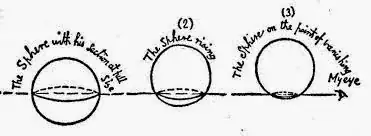Let's imagine a handheld, five-dimensional melee weapon: 3 dimensions of regular ol' space, 1 of time, and an extra dimension of space. Its "hilt" is anchored in our usual 4-dimensional spacetime, so that we can wield it, but its "edge" is tethered in 5-dimensional spacetime. Perhaps also the "edge" can phase down to 4 dimensions when the wielder decides to "collide" with an object in our space.
How would this weapon function? What unexpected advantages would it have for the wielder? Unexpected dangers?
- One possible function I can imagine is that you would be able to strike people with the weapon at long distance, since it could "shortcut" through our space.
- I also imagine it could slice through things to strike objects. Say, stab someone from behind a wall without cutting through the wall.
Useful visualization if you are unfamiliar with higher dimensions: A 5-dimensional object passing through our space would be analogous to a 3-dimensional sphere passing through a 2-dimensional world sheet. Imagine a basketball passing through a sheet of paper. The cross-section of the ball, which is the only thing comprehensible to sheet-dwellers, can be visualized by them as a circle appearing out of nothing, shrinking, growing, then shrinking again before it disappears, as it passes through the 2 dimensional sheet.
Commenter Questions:
- The weapon can be smart or dumb.
- Some question whether the hilt can be affected by the edge (that is, whether it is possible to move the edge by the hilt at all, since 2d objects are not known to exist). This implies the weapon is artificial in its construction, and thus we must assume interaction is possible in order to be able to speculate, so it just is.
- To be clear, moving the hilt moves the 5d edge; rotating the hilt rotates the 5d edge; squeezing the hilt makes the edge 4d so that it can strike objects in lower dimensional space.
Relevant:
